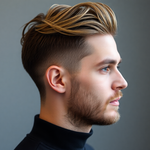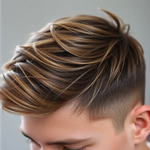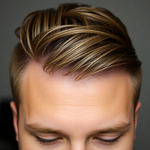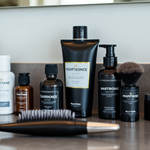
Semi-Permanent Hair Color: A Visual Palette Checklist to Match, Mix, and Multiply a Men's Capsule Wardrobe
15 October 2025
Share
Hook — upgrade your look without a wardrobe overhaul
Semi-Permanent Hair Color is one of the easiest, lowest-risk ways to refresh your appearance and instantly elevate a men's capsule wardrobe. If you're tired of the same outfits feeling flat, a small hair tone shift can create contrast, add warmth, or sharpen a monochrome look—no new shopping required. Read on for a step-by-step visual palette checklist, color pairings, product tips, and maintenance routines built for men aged 18–45 who want impact without drama.
Semi-Permanent Hair Color: What it is and why men choose it
Semi-permanent hair color deposits pigment on the hair surface and gradually fades over weeks. It contains no ammonia and minimal peroxide, so it doesn't penetrate like permanent dye. That means less commitment, less damage, and a safer way to experiment with tones that complement your capsule wardrobe. Use it to mask early greys, add depth to a receding hairline, or introduce subtle highlights that make your face and outfits pop.
Semi-Permanent Hair Color: How it Enhances a Capsule Wardrobe
Think of your capsule wardrobe as a limited color set—navy, gray, white, olive, and denim. Your hair is the crown of that palette. A slight shift in hair tone multiplies outfit combinations by improving cohesion and visual contrast. Below is a detailed visual checklist to help you match, mix, and multiply looks without breaking the bank or your grooming routine.
Phase 1 — Audit: Know your wardrobe's dominant palette
Before choosing any hair color, audit your clothes. Lay out 12–15 of your go-to pieces and group them by tone and mood.
- Cool neutrals: navy, charcoal, slate, cool whites
- Warm neutrals: olive, tan, camel, rust
- High-contrast basics: black and crisp white
- Denim and blue family
This tells you whether your capsule skews cool, warm, or neutral—critical for selecting complementary hair tones.
Phase 2 — Personality & purpose: Decide what the change should do
Ask yourself: do you want to look sharper for interviews and dates, warmer for casual weekends, or more modern and edgy? The intended purpose will narrow your choices:
- Sharp & professional: deeper, cool-brown or espresso shades enhance jawlines and suit navy/gray wardrobes.
- Warm & approachable: chestnut, honey, or bronze tones pair with olive or tan palettes.
- Modern & edgy: blue-black or graphite tones lift monochrome and streetwear looks.
Phase 3 — The Visual Palette Checklist (detailed)
- Shade range: Choose a semi-permanent color within one shade lighter or darker than your natural color for subtlety.
- Undertone match: Match hair undertones to your dominant wardrobe—cool hair for cool clothes, warm hair for warm clothes.
- Face-framing strategy: Add a slightly lighter tone around the temples and bangs to brighten the face; avoid extreme contrasts for conservative looks.
- Texture consideration: Thicker, textured hair holds deeper pigments better; finer hair shows highlights more quickly.
- Accessory coordination: If you wear beards, ensure beard color aligns with hair tone—use beard tinting products if needed.
- Fade plan: Plan touch-ups around haircuts to maintain intentionality. Semi-permanent fades look best when tied to a haircut schedule.
- Test & document: Do a strand test and photo every two weeks to track fade and how colors play with outfits under natural light.
Practical Pairings — match, mix, multiply
Here are tested pairings based on common capsule styles:
- Classic Navy/Gray Capsule: Cool espresso or ash-brown. Why: reinforces the cool palette and adds depth without drawing attention away from clean lines.
- Earthy / Outdoor Capsule (olive, brown, tan): Warm chestnut or honey bronze. Why: complements greens/tans and makes skin look healthy in natural light.
- Minimal Monochrome (black, charcoal): Deep blue-black or soft graphite. Why: enhances the edge of a monochrome look and keeps texture visible on matte fabrics.
- Denim & Casual (indigo, chambray): Sun-kissed light brown or subtle copper. Why: warms the face and plays nicely with indigo undertones.
- High-contrast Business Casual (white shirt, navy blazer): Neutral dark brown with subtle warm undertones. Why: balances crisp whites and maintains a professional silhouette.
How to choose the exact semi-permanent shade
- Match your natural level: If your hair is a level 3–4 (dark brown), stick to 2–5 to avoid muddying your color.
- Consider skin undertone: Blue/olive undertones work best with cooler shades; warm or golden skin tones pair with warmer pigments.
- Think lifestyle: If you work outdoors or sweat a lot, choose richer pigments that resist faster fading.
- Use a professional consult for dramatic shifts: If you want dramatic lightening, book a colorist—semi-permanent won't lift dark hair significantly.
At-home application: 10-step routine
- Buy a semi-permanent kit from a reputable brand or pick Menll.com's color-friendly aftercare if you need maintenance products.
- Do a skin patch test 48 hours ahead to check for allergic reaction; see guidance from the American Academy of Dermatology at aad.org.
- Perform a strand test on an inconspicuous area to preview the shade under daylight.
- Wash and fully dry hair; most semi-permanent formulas apply best to clean shafts.
- Apply gloves, section hair, and saturate evenly from roots to ends or focus on face-framing areas for subtlety.
- Follow the kit timing precisely; don’t leave longer than recommended for semi-permanent dyes.
- Rinse with cool water until water runs clear; apply a color-safe conditioner.
- Dry and style; take before/after photos in natural light.
- Record the product name, shade number, and timing for replication.
- Plan to use sulfate-free shampoo and a weekly color-protect mask to prolong vibrancy.
Maintenance and longevity — keep it looking deliberate
Semi-permanent typically lasts 4–8 weeks depending on hair porosity and wash frequency. To maximize life:
- Use cold or lukewarm water—hot water accelerates fade.
- Limit washes to 2–3 times per week when possible; dry shampoo helps on off days.
- Choose a color-safe, sulfate-free shampoo and a weekly color-depositing mask if you want to nudge tone back between applications.
- Schedule touch-ups around every 4–6 weeks for consistent results tied to haircuts.
Styling and grooming hacks that maximize the effect
- Trim beard and neckline when you color your hair so the whole head looks unified.
- Use matte pomades or low-shine creams to show texture and color depth.
- Accessorize intentionally—scarves, watches, and eyewear can highlight warm or cool undertones.
What to avoid (common mistakes)
- Jumping more than two levels lighter at home—results can be uneven and brassy.
- Mixing multiple semi-permanent shades without testing—unpredictable tones and patchiness can result.
- Using clarifying shampoos after coloring—these strip dye faster and may leave brassiness.
Real men, real gains — stories and scenarios
Picture this: Matt, 28, had a navy-heavy capsule and felt washed out on Zoom calls. He chose a cool espresso semi-permanent and noticed his shirts read sharper against his face—clients commented he looked "more put together" and he felt more confident in meetings. Or, take Diego, 33, whose wardrobe was olive and tan; a honey-bronze tone made weekend photos look warmer and reduced the need to buy new pieces to feel refreshed.
Visual assets & accessibility — create shareable content
Use simple photos: before/after front and side shots in daylight, and one outfit photo to show how the hair tone works with a go-to look. If you create images with a generator like Jolt, align them with Menll.com's aesthetic: clean, minimalist, and slightly rugged. Add alt text like 'man with warm chestnut semi-permanent hair wearing olive jacket' for SEO and accessibility.
Product note — sustainable grooming that supports the look
For aftercare and styling, Menll.com's grooming collection offers sulfate-free shampoos, color-protect conditioners, and low-waste styling products designed to maintain toned looks. If you want to shop sustainable grooming that pairs with a capsule wardrobe, start with Menll.com's grooming collection: Menll.com grooming. For more on building the capsule itself, see our guide at How to Build a Capsule Wardrobe.
SEO meta suggestions
Meta title: Semi-Permanent Hair Color: Palette Checklist for Men
Meta description: Use this detailed visual palette checklist to match, mix, and multiply a men's capsule wardrobe with semi-permanent hair color—shade guides, application, and upkeep.
Final printable checklist
- Wardrobe color audit completed
- Target effect chosen (sharp, warm, edgy)
- Shade within one level of natural selected
- Patch and strand tests done
- Color-safe products acquired (sulfate-free shampoo & mask)
- Photos and notes documented for replication
Join the conversation
Which hair tone are you most tempted to try to multiply your capsule wardrobe? Drop a comment below and tag a mate who needs this hack. Ready to maintain the look sustainably? Browse Menll.com’s grooming collection for color-friendly, low-waste products that keep your style consistent.
Prev post

Semi-Permanent Hair Color: Shade Anchors That Replace Extra Pieces in a Minimal Men's Capsule Wardrobe
Updated on 16 October 2025
Next post

Semi-Permanent Hair Color: A Two-Tone Shade Strategy to Double Looks from a Minimal Men's Capsule Wardrobe
Updated on 13 October 2025





